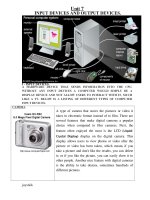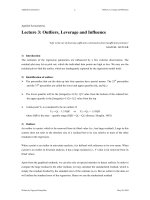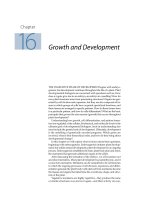Lecture 7 money growth and inflation
Bạn đang xem bản rút gọn của tài liệu. Xem và tải ngay bản đầy đủ của tài liệu tại đây (8.3 MB, 41 trang )
Macroeconomics
Lecture 7
.
Money Growth &
Inflation
Chapter 28
.
In this chapter, you will study:
The definition and measures of inflation
Two types of inflation.
The causes of inflation and the quantity
theory of money.
The relationship between inflation and
interest rates.
The costs of inflation.
.
Inflation
Inflation
An increase in the overall level of prices in
the economy
Inflation rate
The percentage change in the price level
from the previous period
.
Inflation & Its Historical Aspects
Inflation
Deflation
A decrease in the overall level of prices in the
economy (the U.S. 1818-1821)
Disinflation
A reduction in the rate of inflation (Vietnam
2011-2013)
Hyperinflation
An extraordinary high rate of inflation
(Germany after World War I)
.
Hyperinflation in Venezuela
Replacing toilet paper with
cash would seem an
extremely affluent action in
most countries. But in
Venezuela, it's now the
financially prudent thing to
do.
.
Types of Inflation
Demand-pull inflation
Cost-push inflation
.
Demand-Pull Inflation
Occurs when Aggregate Demand grows up
quickly and runs ahead of Aggregate Supply
for goods and services
Supply cannot increase accordingly because
it is constrained by factor supplies (labor,
technology, natural resources and capital)
Excess demand enables suppliers to increase
the prices of their limited products
.
Demand-Pull Inflation
.
Cost-push Inflation
Occurs when there is a rise in production
costs (wage and salary, raw material and
components, government taxes, ect)
Profit margin decrease: a rationale for
reducing supply (the law of diminishing
marginal returns)
Suppliers increase prices to compensate
partly for deacrease in profit margin,
passing a part of their loss on to consumers
.
Cost-push Inflation
.
The level of prices and the
value of money
Price level (P): number of dollars needed
to buy a basket of goods and services
Value of money (1/P): number of goods
and services bought by each dollar
=> P => 1/P
=> When the price level rises, the value of
money falls.
.
Money Supply, Money Demand,
and Monetary Equilibrium
Money
Supply (MS)
• Determined by the Central Bank and the
banking system
• Assumptions: The quantity of money
supplied is a policy variable that the
Central Bank controls directly and
completely
.
Money Supply, Money Demand,
and Monetary Equilibrium
Money Demand (MD)
Determined by many factors: the level of
reliability on credit cards, whether an
ATM is easy to find, the interest rate, the
overall price level in the economy
In the long-run, the overall price level
turns out to be the most important
determinants
.
Money Supply, Money Demand,
and Monetary Equilibrium
Monetary Equilibrium: The point at
which the quantity of money demanded
balances the quantity of money supplied
.
Money Supply, Money Demand, and
the Equilibrium Price Level
Value of
Money (1/P)
Price
Level (P)
Money supply
(High) 1
1 (Low)
1.33
A
1/2
1/4
(Low) 0
2
Money
demand
Quantity fixed
by the Central Bank
.
4
Quantity of
Money
Equilibriu
m price
level
Equilibrium
value of money
3/4
(High)
The Effects of Monetary Injection
Value of
Money (1/P)
MS1
2
(High) 1
1. An increase
in the money
supply...
3/4
A
1/2
Money
demand
(Low) 0
M1
.
1.33
2
B
1/4
1 (Low)
M2
4
Quantity of
Money
3. …and
increases the
price level
2. ...decreases the
value of money ...
Price
Level (P)
MS
(High)
The Quantity Theory of Money
Quantity
theory of money: explains how
the price level is determined and why it
might change over time
The quantity of money available in the
economy determines the price level.
The primary cause of inflation is the growth
in the quantity of money.
.
Classical Dichotomy and
Monetary Neutrality
Classical Dichotomy: the separation of
economic variables into two groups:
• Nominal variables: variables measured in
monetary units
• Real variables: measured in physical units
Monetary neutrality: changes in the
money supply affect nominal variables but
not real variables.
.
Velocity and the Quantity Equation
Velocity of money: the speed at which the typical
dollar bill travels around the economy from wallet
to wallet.
MxV=PxY
Where:
V = velocity
P = the price level
Y = the quantity of output
M = the quantity of money
·
P x Y = nominal value of output
.
The Quantity Theory of Money
M = (P x Y)/V
An
increase in the quantity of money (M)
Changes in other three variables
.
Indexes
(1960 = 100)
Quantity of Money and the
Velocity of Money in USA
1,500
Nominal GDP
M2
1,000
500
Velocity
0
1960
1965
.
1970
1975 1980
1985
1990
1995
2000
The Quantity Theory of Money
•
•
•
V: relatively stable.
M (P x Y).
Money is neutral does not affect Y
M P
=> Rapid increase in money supply causes
high inflation rate
•
.
Case Study: Money and prices
during four hyperinflations
(a) Austria
(b) Hungary
Index
(Jan. 1921 = 100)
Index
(July 1921 = 100)
100,000
100,000
Price level
Price level
10,000
10,000
Money supply
1,000
100
Money supply
1,000
1921
1922
.
1923
1924
1925
100
1921
1922
1923
1924
Copyright © 2004 South-Western
1925
Case Study: Money and prices
during four hyperinflations
(c) Germany
(d) Poland
Index
(Jan. 1921 = 100)
100,000,000,000,000
1,000,000,000,000
10,000,000,000
100,000,000
1,000,000
10,000
100
1
Index
(Jan. 1921 = 100)
10,000,000
Price level
Money
supply
Price level
1,000,000
Money
supply
100,000
10,000
1,000
1921
1922
.
1923
1924
1925
100
1921
1922
1923
1924
Copyright © 2004 South-Western
1925









